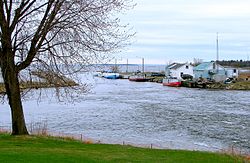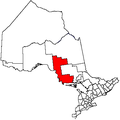Blind River, Ontario
Blind River | |
|---|---|
| Town of Blind River | |
 | |
| Country | |
| Province | |
| District | Algoma |
| Government | |
| • Type | Town |
| • Mayor | Sue Jensen |
| • MP | Carol Hughes (NDP) |
| • MPP | Michael Mantha (NDP) |
| Area | |
| • Land | 526.46 km2 (203.27 sq mi) |
| Population (2011)[1] | |
| • Total | 3,549 |
| • Density | 6.7/km2 (17/sq mi) |
| Time zone | UTC−5 (EST) |
| • Summer (DST) | UTC−4 (EDT) |
| Area code | 705 |
| Website | www.blindriver.ca |
Blind River is a town situated on the North Channel of Lake Huron in the Algoma District, Ontario, Canada. The town, named after the nearby Blind River, celebrated its centennial in 2006.
History
French explorers discovered the North Channel and made it a renowned voyageur route. Fur traders, loggers and miners followed to seek natural resources. A fur trading post was established by the North West Company in 1789 at the mouth of the Mississagi River. When the fur trade slowed about 1820, the Hudson's Bay Company purchased the North West Company. A number of trappers settled along the rivers flowing into Lake Huron. One of these rivers, just three miles (5 km) east of the Mississagi mouth, was called Penewobecong, which translates to "smooth rock or sloping". The voyageurs named this river the Blind River because the mouth was not visible along the canoe route. The name Blind River was adopted by the settlement that grew at the mouth of the river. The logging industry developed because of the accessibility of timber along the Blind River and Mississagi watersheds. The industry was spurred by a copper discovery in the mid-19th century in Bruce Mines. The first sawmill was built beside the mouth of the Blind River at the current site of the Old Mill Motel. The protected estuary of the east arm of the Blind River as well as the deep water offshore offered a good location for the mill. The sawmill provided timber and planks for the copper mine. By 1906 when Blind River had been incorporated as a town, a second larger sawmill had been erected on the west arm of the Blind River. Today the west arm is the location of the Blind River Marine Park. In 1929 the Carpenter Hixon Company built a state-of-the-art pine sawmill producing 89 million board feet of lumber in its first year. Through boom and bust the mill survived under the name McFadden Lumber Company for over forty years as the largest white pine sawmill east of the Rocky Mountains, with an annual capacity of 120,000,000 board feet (280,000 m³) of lumber (an output never reached in actual production.) The Great Mississagi Fire of 1948[2] led to a depletion of timber, difficult economic conditions and the eventual closing of the mill in 1969. The lumber history is commemorated in the Timber Village Museum.
In 1955 uranium was discovered near Blind River. The first uranium mine began operation as the Pronto Mine in Algoma Mills. Although its life was short-lived, its significance was that it led to the discovery of the entire Blind River-Elliot Lake uranium mining camp. In 1983 a uranium refinery was built just west of Blind River. This uranium refinery is owned and operated by the Cameco Corporation, which processes uranium concentrates from all over the world into uranium trioxide.
The town of Blind River made headlines in 1991 for a double murder that occurred at the local rest stop off the Trans-Canada Highway. On June 28, 1991, an unknown assailant shot an elderly couple from Lindsay, Ontario, Gord McAllister, 62, and his wife Jackie, 59, and 29-year-old Brian Major. The killer gained entry into the McAllisters' motor home by posing as a police officer. Jackie McAllister and Brian Major died of their wounds. The case was profiled in 1993 on NBC-TV's Unsolved Mysteries. No one has ever been charged in the murders, although a suspect, Ronald Glenn West (a former Toronto police officer convicted of two rape-murders in Toronto in 1970, for which he is currently serving two life sentences, and of a series of robbery-assaults in Sault Ste. Marie in 1995), remains under suspicion. Gord died on February 14, 2012.
Until 1997, Blind River had its own radio station, CJNR-AM 730. In 1997, the station was absorbed into the new CKNR-FM, based in Elliot Lake.
Demographics
| 2011 | |
|---|---|
| Population | 3549 (-6.1% from 2006) |
| Land area | 526.46 km2 (203.27 sq mi) |
| Population density | 6.7/km2 (17/sq mi) |
| Median age | |
| Private dwellings | 2248 (total) |
| Median household income |
Population trend:[6]
- Population in 2011: 3549
- Population in 2006: 3780
- Population in 2001: 3969
- Population in 1996: 3152 (or 4374 when adjusted for 2001 boundaries)
- Population in 1991: 3355
Economy

Its main businesses are tourism, fishing, logging, and uranium refining.
Transportation links are Highway 17 (part of the Trans-Canada Highway), the Huron Central Railway operating on the leased Canadian Pacific Railway line that runs through the town, and the Blind River Marine Park, a town-owned marina servicing pleasure craft. A 1991 study by the Ontario Ministry of Transportation proposed the extension of Highway 555 (Granary Lake Road) from Blind River to meet Spine Road in Elliot Lake, creating a new route which would reduce the length of a commute between the two communities by approximately 20 kilometres.[7] Although the ministry has announced no firm plans to construct the proposed road, Elliot Lake City Council passed a motion in August 2015 calling for the project's revival on the grounds that it would provide significant economic benefit to both communities.[7]
The town also provides services to the surrounding communities through its District Health Centre, two high schools (W.C. Eaket Secondary School and École secondaire catholique Jeunesse-Nord) and three elementary schools (Blind River Public School, St. Mary's Catholic School and the French-language École Catholique St-Joseph). Blind River has seven churches, as well as a Kingdom Hall located just outside the town, and a variety of merchants and service industries.
Blind River has many beaches on Lake Huron, including Fourth Sand, Sellers Park, Boom Camp, Forest Glen Beach, as well as many others. Blind River is home to a large uranium refinery operated by the Cameco Corporation, which is situated just outside town as well as a world-renowned golf course by the name of Huron Pines Country Club, which is just a mile away from one of the longest running businesses in the area, MacIver's Motel & Camp Ltd, which has been family operated for over 70 years.
It is also home of Lauzon Aviation Co. Ltd and the Makela Family since 1959. Lauzon Aviation is a family owned and operated outfitter offering Fly-In Hunting & Fishing Wilderness Vacations. They have appeared in several TV episodes of Fishing Canada and The New Fly Fisherman and featured in articles in Ontario Out of Doors, Field & Stream, Outdoor Life and published Trade History of the North Shore and Lake Huron.
Sports and culture
- The town is home to the Blind River Beavers of the Northern Ontario Junior Hockey League.
- Home town to Claude Julien, current head coach for the Boston Bruins of the National Hockey League.
- Canadian singer Neil Young makes reference to Blind River in his song "Long May You Run", a story about the demise of his 1948 Buick Roadmaster hearse.
Well, it was back in Blind River in 1962
When I last saw you alive
But we missed that shift on the long decline
Long may you run.
- The Voyageur Hiking Trail passes near the town.
- Wade Hemsworth's "The Black Fly Song", about a survey crew in northern Ontario in 1949, has a verse about a cook named "Blind River Joe".
- In the 1959 film, Anatomy of a Murder, the character Mary Pilant, played by Kathryn Grant, was born in Blind River, Ontario.
- The Blind River Beavers are mentioned in the 1986 film Youngblood, starring Rob Lowe and Patrick Swayze.
- Home to local company "Wandering-Elk Promotion & Productions" which is owned & operated by Guy Serre, who is the host and producer of the annual Civic Weekend Concert
"Rocking on the River" in Blind River, held on a piece of property located on 135 Royer St/Rd off Hwy #557 just north of the downtown core since 2010.[8]
See also
References
- ^ a b "Blind River census profile". 2011 Census of Population. Statistics Canada. Retrieved 2012-02-16.
- ^ Michael Commito, " 'The Biggest, Blackest Graveyard': A Socioeconomic History of the Mississagi Fire and Salvage, 1948-1973" Masters Thesis, Laurentian University, 2010.
- ^ "2011 Community Profiles". 2011 Canadian Census. Statistics Canada. March 21, 2019. Retrieved 2012-02-16.
- ^ "2006 Community Profiles". 2006 Canadian Census. Statistics Canada. August 20, 2019.
- ^ "2001 Community Profiles". 2001 Canadian Census. Statistics Canada. July 18, 2021.
- ^ Statistics Canada: 1996, 2001, 2006 census
- ^ a b "Council considers old idea for new road". Elliot Lake Standard, August 5, 2015.
- ^ "Events". Rocking on the River. Retrieved November 1, 2016.

